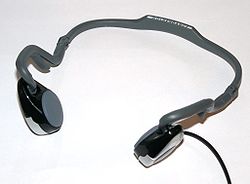- Bone conduction
-
Bone conduction is the conduction of sound to the inner ear through the bones of the skull.
Bone conduction is the reason why a person's voice sounds different to him/her when it is recorded and played back. Because the skull conducts lower frequencies better than air, people perceive their own voices to be lower and deeper than others do.[1][2] This also explains why a recording of one's own voice sounds higher than one is accustomed to.
Some hearing aids employ bone conduction, achieving an effect equivalent to hearing directly by means of the ears. A headset is ergonomically positioned on the temple and cheek and the electromechanical transducer, which converts electric signals into mechanical vibrations, sends sound to the internal ear through the cranial bones. Likewise, a microphone can be used to record spoken sounds via bone conduction. The first description, in 1923, of a bone conduction hearing aid was Hugo Gernsback's "Osophone",[3] which he later elaborated on with his "Phonosone".[4]
Bone conduction products are usually categorized into three groups
- Ordinary products such as hands-free headsets or headphones
- Hearing aids and assistive listening devices
- Specialized communication products (e.g. underwater & high-noise environments)
Bone conduction products have following advantages over traditional headphones:
- Ears-free, thus providing extended use comfort and safety [5]
- High sound clarity in very noisy environments, can be used with hearing protection
- Can have the perception of stereo sound[6]
There are some disadvantages:
- Some implementations require more power than headphones
- Less clear recording & playback than traditional headphones and microphone due to reduced frequency bandwidth
One example of a bone conduction speaker is a rubber over-moulded piezo-electric flexing disc about 40mm across and 6mm thick used by scuba divers. The connecting cable is moulded into the disc, resulting in a tough, water-proof assembly. In use the speaker is strapped against one of the dome-shaped bone protrusion behind the ear. As would be expected, the sound produced seems to come from inside the user's head, but can be surprisingly clear and crisp.
Bone conduction transmission can be used with individuals with normal or impaired hearing. There are several products on the market that exploit the bone conduction transmission pathway for sound. Some of these include the AquaFM and the SwiMP3 which are devices for transmitting sound to swimmers.
See also
- Bone conduction auditory brainstem response
- Bone Anchored Hearing Aid
- Bonephones
- Cochlear Baha
References
- ^ http://www.wanderings.net/notebook/Main/WhyDoesYourVoiceSoundDifferentRecordingPlayback
- ^ http://www.tinnitus.vcu.edu/Pages/Human%20Skull%20Response.PDF
- ^ US 1521287, Gernsback, Hugo, "Acoustic Apparatus", published 19 May 1923, issued 30 December 1924
- ^ Kennedy, T. R., Jr. (1958). "From Coherer to Spacistor". Radio-Electronics (Gernsback Publications) 29 (4): 45–59. http://www.swtpc.com/mholley/RadioElectronics/Apr1958/Coherer_to_Spacistor.pdf.
- ^ Jzool.com. Benefits of Bone Conduction Headphones
- ^ MacDonald, J.A.; Henry, P.P.; Letowski, T.R. (2006). "Spatial audio through a bone conduction interface". International Journal of Audiology (Informa Healthcare) 45 (10): 595–599. http://psych.nmsu.edu/faculty/macdonald/personal/papers/2006_IJA_paper.pdf.
Categories:
Wikimedia Foundation. 2010.

